
Avian Soap Operas
June 1st, 2014
So Sedge Wrens are kind of dastardly.
They are also rare and elusive. They breed in moist tall-grass meadows, where they spend most of their time creeping through said grass. The only time when you really have a hope of seeing one is when it sings. The song at least allows you to hone in on the spot where the wren is creeping through the grass, or, if you're lucky, it might come up a short distance into a bush or onto the top of a tall stalk. The urge to declare territory and/or catch a female wren's eye may briefly overrule the urge to stay hidden. The best time is before the sun is up, or shortly after. These shy birds seem to shrink away from full daylight.
For some reason, they are also very nomadic. A colony of Sedge Wrens may spring up in an area one year, and then disappear from that area for years thereafter for no apparent reason. The going theory among scientists is that good habitat for Sedge Wrens is a very particular and transitory thing, and even a slight change in, say, water level may render a meadow uninhabitable to them. I have an alternative theory, one which also explains why they are so secretive and maybe even whey they are so rare: other birds hate them.
They really do. That by itself (the hate) is more than theory, it's something I've established from repeated observation. I first noticed it back in May of 2012 when I heard a singing Sedge Wren in the Nortel wetland. It was in an odd spot, just a small area of fairly short grass across the trail from the marsh, but I was confident of the ID. A Common Yellowthroat flew towards the song, there was a confusing aerial kerfuffle, and then two birds flew off with one in hot pursuit of the other. Thereafter, there was no more Sedge Wren song. I never saw the bird well enough to list it.
I came back to the spot many more times hoping to see the wren. I even came back in spring of 2013 hoping it would pass through again. Each time I brought a recording device and played Sedge Wren song in hopes of drawing one out. I never got a response from a Sedge Wren, but boy, did I get a response from the other birds! I got scolds, alarm calls, birds flying at me, birds perching in the open and looking in every direction trying to find the singer. The skulking but ever-vigilant Common Yellowthroats were guaranteed to emerge from the undergrowth and give me beautiful looks at themselves whenever I played back the wren.
Why? Because Sedge Wrens are bad neighbors. They are in fact terrible neighbors. These adorable four-inch birds with their delicate staccato songs are little avian sociopaths. They will sneak into the nests of nearby birds (even fellow Sedge Wrens) and methodically puncture every egg. They don't do it (near as we can tell) because they particularly like the taste of eggs. They do it to reduce competition for resources. If their neighbors have no surviving young to feed, that's all the more food for the Sedge Wren's babies. So the birds who share habitat with them have long since evolved to recognize them as a threat. They will do everything they can to dissuade the wrens from settling down to breed.
So--it's a stretch, I know--but could it be Sedge Wrens are so nomadic because they need to burn bridges now and then? That once the area birds are wise to their tricks, adept at harassing them and interrupting their egg-puncturing rounds, it's then time to move on to a fresh batch of
I'd been trying to lifelist this elusive bird for seven years. So when I heard that up to three males were singing in a meadow near the Nortel wetland, I grabbed my scope (the alternative to wading through dew-soaked thigh-deep grass) and rushed out to look for them in the very early morning. I was not disappointed! Over the course of an hour I managed multiple good views. To anyone hoping to do the same, I would offer a few bits of advice: go out there at sunrise or even before the sun is quite up, bring a scope if you have one, and pay special attention to bushes and other elevated spots--they do sometimes ascend when they sing, though they rarely come completely out in the open. And lastly, if there are other birds in the meadow who are acting agitated, follow their eyes. They may be as interested as you are.
This morning I watched as a Red-Winged Blackbird and a robin converged on a bush containing a Sedge Wren (which I could hear but not see.) The instant it dared to sing, they both made their way down towards it, with clear hostile intentions. Its defense: clam up and lay low. Few things are less findable than a Sedge Wren clamming up and laying low. As I watched both birds sit there in the middle of the bush with their eyes glued on the grass below, waiting for it to pipe up again, I was struck by how much they and I resembled each other, the flummoxed birds and the flummoxed birder.
They eventually gave up and left. I didn't. And after the coast was clear, the sneaky Sedge Wren began to sing again.
The Phantom of Carp Ridge
May 27th, 2014
In the wee hours of the morning today, I drove out to Carp Ridge for the nocturnal festival.
There are three nocturnal specialties there. One is the nighthawks. In spring male nighthawks perform spectacular aerial dives to impress their prospective mates. The most spectacular part is the sound: when they dive the wind whooshes through their wings with a *zoom*. I think I have described the sound before as like a tiny sportscar whizzing past your ear. But that's how it sounds when there's still light in the sky. By night they get bolder, and it's more like a full-size fighter jet whizzing past your ear.
The aerial dance of the woodcocks is the second attraction. While the nighthawks "peent" from the sky, woodcocks "peent" as they strut on the ground, then finally they take off with a twittering of wings, circling overhead. The twittering changes to chirping as they descend, finally landing in exactly the same spot on the same rocky clearing as before. On a warm spring night Carp Ridge is alive with these sounds, nasal "peent"s, sudden *zoom*s, and a twittering that seems to come from all directions (and that if you didn't know better, you'd probably assume was bats.) It must be experienced to be believed.
But the star attractions, the ones that haunt me, are the whippoorwills. For seven years I've sought them. Last spring I heard one for the first time since childhood. But to see one is a great deal harder. There's already little light left in the sky when they first start to sing, distantly, from the woods. By the time they make their way out to the roadsides it's almost dusk. Time after time I'd listen to the breathlessly repeated "whip-poorWEEL! whip-poorWEEL! whip-poorWEEL!" while struggling to see the bird that sounded like it was only just past the shoulder, less than ten feet away, and, if field guides are to be believed, perched in the open on a rocky shelf or on the ground. And I'd never see it.
I told my husband that they seemed to have both powers of invisibility and powers of teleportation. Both were necessary to explain it. Because eventually the whippoorwill would stop singing, and then I would immediately hear it singing from down the road, without having seen or heard any sign of its flight. (I think I've cleared that mystery up, though. Because two whippoorwills singing at once is not a harmony but a cacophony, they seem to have come to a gentlemen's agreement that only one in a given area shall sing at a time. So once one bird finally runs out of breath, the next one starts up.)
Last night (or this morning, it gets fuzzy at 4am), I finally discovered the secret: eye shine. You don't have to point the flashlight right at them, and of course you shouldn't! (Just point one at your own eyes for a moment and imagine what that could do to a nocturnal bird.) Shine it on the road nearby. Mild indirect light doesn't seem to bother them, indeed they don't even seem to notice it. But their eye will catch the light and glow, a perfectly outlined orange circle, looming large. Even through a dense thicket you can see it. It's downright eerie, actually--especially when that glowing circle shifts, then dances away. It gives me a fresh appreciation for the superstitious folklore that once surrounded these birds.
Time and again I saw the eyeshine. A few times I saw the brief outline of a wing when it flew. And while it was still too dark for me to get the proper view I had always hoped for, I began to feel that there was something more proper, more true, more essentially whippoorwill about this phantom figure with a glowing eye, than if I had seen the body and the plumage.
Be that as it may, I did finally get what I'd always hoped for. In the first light of dawn at quarter to five, I saw one clearly. By some optical illusion it loomed large in my binoculars, looking much more imposing than the nine and a half inches I was given to expect, but there was no doubt what it was. It was more than a silhouette. I could see its brown and gray plumage, and how seamlessly it blended in to the lichen-encrusted rock. It had been calling softly before, but now that my sights were on it, it was completely silent and still.
I looked away for a moment to swat mosquitos. When I looked back, it was gone.
Marsh Slinkers
May 23rd, 2014
Here in Ottawa we have an ostensibly common bird called a Virginia Rail. It took me over a year of trying to see one. And it has taken me over five years of trying to get a picture of one.
Rails are incredibly bashful. They spend their lives creeping, mouselike, through thick stands of cattail. Their bodies are laterally compressed to allow them to squeeze through narrow gaps between reeds. (Supposedly, they're where the phrase "skinny as a rail" comes from.) You never see them in flight. They don't flush when disturbed, they just slink away.
The trick, as it turns out, is sound. When you play back a recording of their mating call at the right time of year (spring, mainly), they just can't resist checking it out. And that is to thank for this:
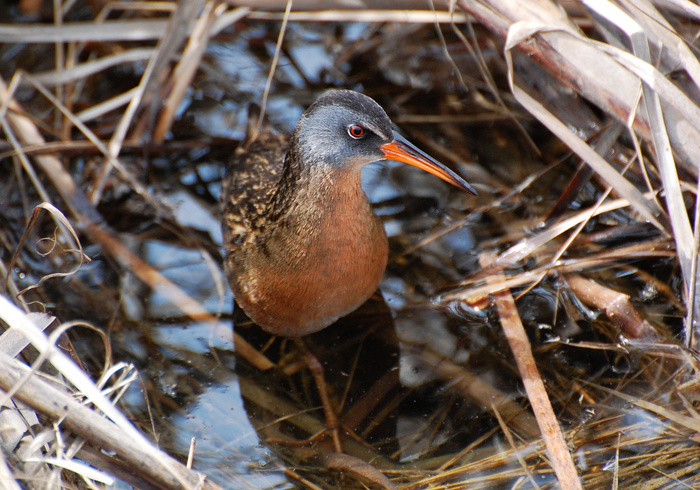
1680x1050 wallpaper
This handsome fellow came all the way out to the edge of the marsh for me. He and his mate had responded vociferously to my playback, and he emerged with the intent to send his (imaginary) rival packing. A car going by quickly sent him scurrying back into the reeds. Having had my one good look, I stopped playback. It's important to let the territorial male think he's "won" the exchange.
Look carefully in the water--you can see his toes splayed out. Rails are closely related to gallinules (such as the young Purple Gallinule I showed from the El Rey wetlands), and like them, have long spindly toes suited for walking on boggy ground.
It was only a few days later that I got my first picture of a Sora rail after five years of trying. Soras are the answer to the question, "could any birds be more impossible than Virginia Rails?" They're less common, and in my experience, even shier. I have read field guides claiming that Soras are bold and confiding (y'know, for rails) and will readily feed out in the open. I don't know what kind of cruel joke those field guides are trying to pull, but needless to say, that has not been my experience. Even Sora calls are a form of camouflage. Their most common spring vocalization is a plaintive "ker-wee?" that sounds just like a spring peeper.
(And neither Virginia Rail nor Sora can hold a candle to the famously impossible Yellow Rail. In Larry Neily's words, "to actually see one, you'll need a miracle." It is not yet on my lifelist.)
At the Nortel wetland, a Sora began to vocalize nonstop soon after I started playback. I stopped after a few rounds to avoid causing undue excitement, but the vocalizing continued. It was only a single individual calling this time, and I got the distinct impression that it was not an angry territorial sora, but an unmated sora hoping very much that it was about to get lucky. I thought sure this very excited rail would soon appear, but I must have sat there for at least fifteen minutes without so much as a glimpse--even a hint of movement--even though it sounded like it was ten feet away from me.
Just when I was about to come to the conclusion that I had gotten fooled by a frog, I saw it: a faint silhouette behind the reeds. For about five more minutes I watched the silhouette, its neck arching back with every "ker-wee." And then, at last, a curious face poked out of the tent of cattails.

1680x1050 wallpaper
When I came back through almost an hour later, it was still vocalizing. Sorry to get your hopes up, fella. I hope a real opposite-sex-sora comes along soon.
Death Of A Camera
May 18th, 2014
The inevitable has happened. After years of faithful service, my camera has given up the ghost.
At least you can say it died doing what it loved. I was out at South March Conservation Forest today, getting a slew of photos of birds and flowers on an unseasonably frigid but beautiful morning. It was just after I had taken my best picture ever of a particularly gorgeous species of songbird that the shutter gave out.
So there will be those, and there will be more, since I've built up a backlog of unposted Ottawa pics while I've been blogging about Costa Rica. And then that will be all for awhile. Unless the repairs are cheaper than I expect, I'll be buying a new camera body, which probably won't happen until after Christmas.
Scenery for a change
May 17th, 2014
Pretty sunset in Kanata today.
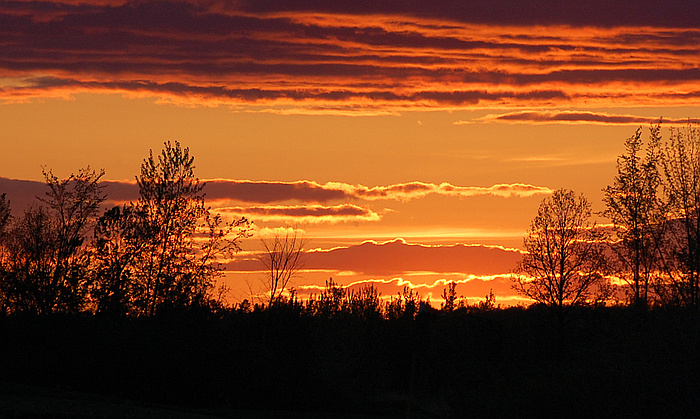
1680x1050 wallpaper
And all the rest...
May 16th, 2014
Some final photos from Costa Rica, followed by my triplist. The permanent home for pictures from this trip will be here.
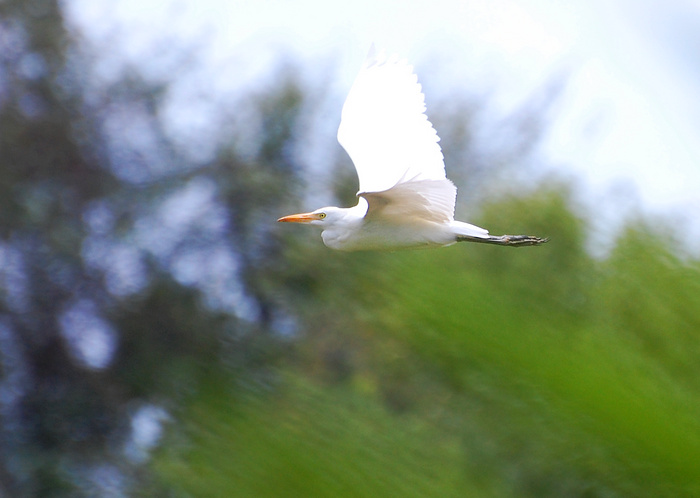
Cattle Egret - wallpaper available
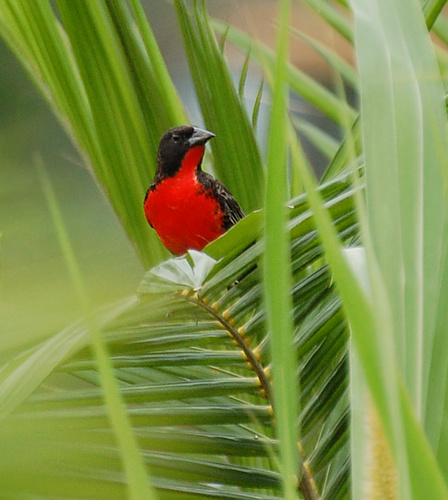
Red-Breasted Blackbird - wallpaper available
A flock of these gorgeous icterids descended on the baby palms one morning while I was out birding. I never saw them after that. Despite the name, they are more closely related to our meadowlarks than to other blackbirds.
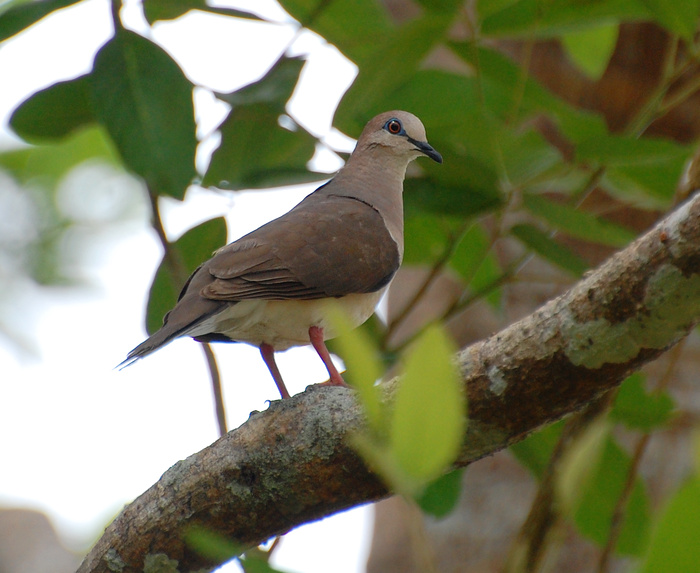
White-Tipped Dove
The blue orbital skin, i.e. the blue around the eye (more visible at high res), is the only reliable way of distinguishing this bird from a Gray-Headed Dove, which has red instead. Interestingly, in areas where Gray-Headed Dove doesn't occur (and thus no confusion could occur), the White-Tipped's orbital skin is red. It's not the only case I've heard where birds seem to have certain features for the sole purpose of telling each other apart. Or maybe they're just helping us bird-watchers out!
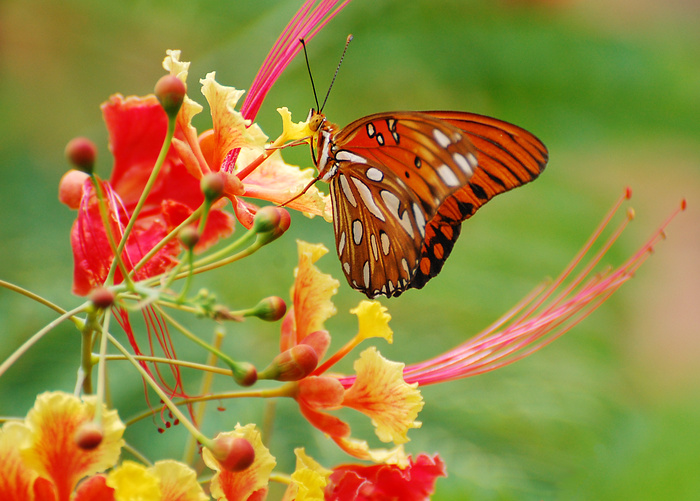
Gulf Fritillary - wallpaper available
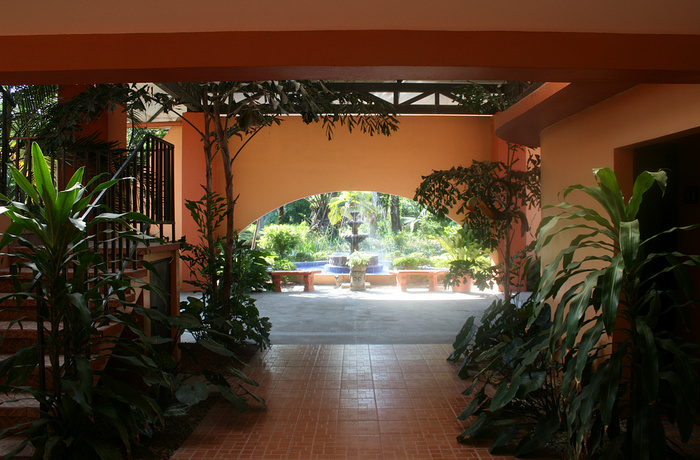
Photo by Michael Britton
The view out to the front garden from our resort. Just looking at this picture makes me nostalgic!
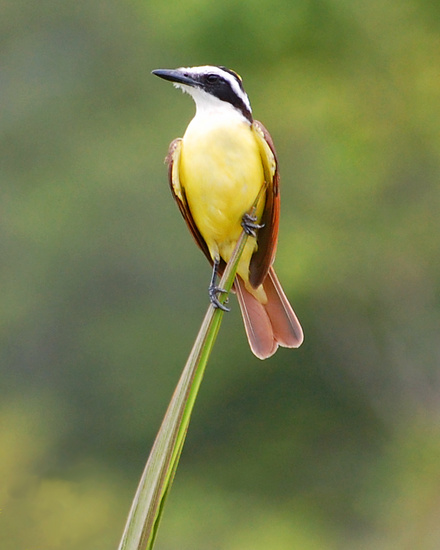
Great Kiskadee - wallpaper available
( More photos and the final triplist )
And now, big damn spider
May 13th, 2014
Our guide called her a Banana Spider. She had built her web behind the shelter at the start of the trail.

1680x1050 wallpaper
Please understand that this is not the wonders of macro photography making a tiny thing (or small thing, or reasonably-sized thing) look huge. I don't have a macro lens. I have a modest-length telephoto lens, and it filled the frame. I have held a tarantula in my hand before, and I think this spider was bigger than the tarantula.
But there's more. See the tiny spider in the web with her? That's not her baby, or some other, much, much smaller species about to become her dinner. That's her mate. That's what a male Banana Spider looks like.

The Rainmaker Tour
May 11th, 2014
On our last day in Costa Rica we went on a tour of Rainmaker, a privately-owned rainforest, organized by our resort and led by Roger. One of my happy early discoveries at Pueblo Real was that two of the men who worked the front desk, Roger and Oscar, were passionate birders. They were professionals, in fact, who led tours and only worked the desk as a side job. Both were very friendly, spoke excellent English, and were ever willing to share their advice and expertise. Oscar even took us birding for free a few times.
Rainmaker was the most tropical experience I had on this vacation. It was all you imagine when you hear the word "rainforest": giant trees, tarzan vines, sweeping vistas. Alas, I decided early on that it would not be a camera day, not with wavy suspension bridges and mandated walking sticks. Mike did decide to use his camera and got a bunch of scenery shots, of which I have a few favorites. As usual, click on any of these for a higher res version.
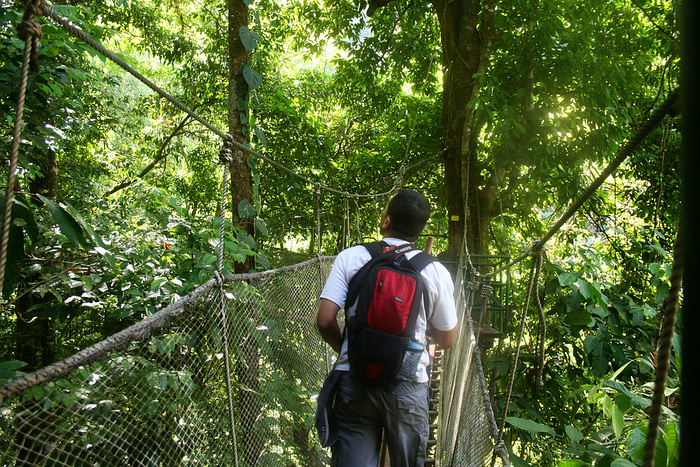
Photo by Michael Britton
Our fearless leader :-)

Photo by Michael Britton
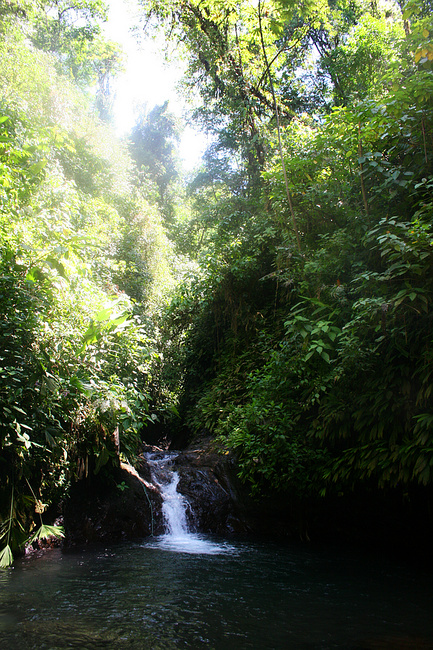
Photo by Michael Britton
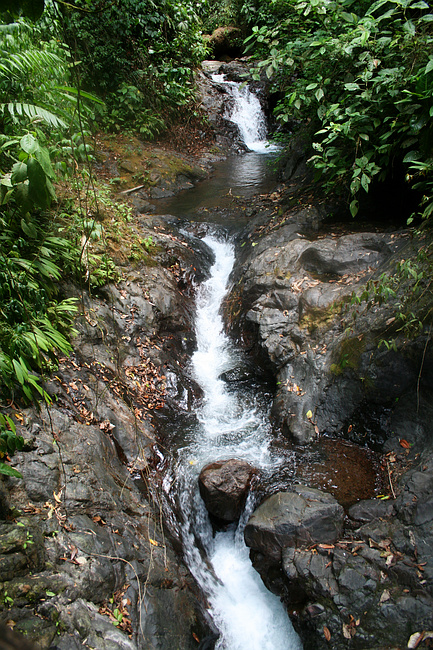
Photo by Michael Britton
As for me, I took photos of just one subject. I'll save those for my next post.
Late morning and it was time for a swim in the pool beneath the waterfall. Except...the birds were calling me. All morning I'd longed to see more of them, but the noise and activity of the two children in the group kept them at bay. So when Roger offered to take me around birding while the rest of the group swam, the waterfall, pristine and inviting though it was, had to be passed up. "Unless you'd like to swim," I said.
Roger replied, and I quote, "pff."
So we went around a bit, not getting too far from the group, and were rewarded with excellent views of a Buff-Rumped Warbler hopping from rock to rock in the stream below the falls. Buff-Rumpeds are "resident" warblers in Costa Rica: they actually live out their lives in the tropics instead of flying to North America to breed. They're always found near flowing water, with a loud, ringing song that can be heard over the roar of a waterfall. I found their habits very similar to those of our own Louisiana Waterthrush (a rare warbler in this area, but it's been known to nest at Lauriault Falls.) Waterthrushes are some of my favorite birds, and I loved Buff-Rumped Warblers as well.
The "good bird" of the day was a Stub-Tailed Spadebill. I am Roger's backup for his claim of having seen one (having seen it also, and pegged it as such independently), since it was believed to have been extirpated from the region!
And the floodgates open
May 9th, 2014
We interrupt your regularly scheduled Costa Rica photo albums to announce that warblers have arrived in Ottawa. Oh. my. god. have they arrived.
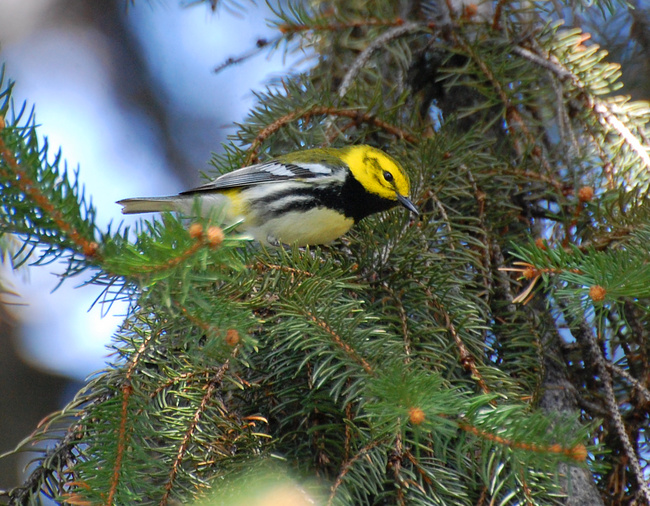
1680x1050 wallpaper
This Black-Throated Green Warbler was practically begging to be photographed. As the guy next to me said, "he certainly seems to think he's important!" These beauties actually nest in our area (Stony Swamp, South March Highlands, Gatineau), but it's hard to see them on their breeding grounds. They tend to stay high up in the trees.
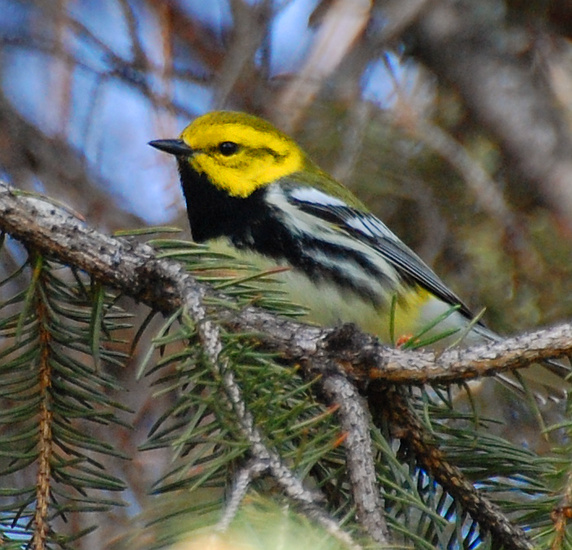
1680x1050 wallpaper
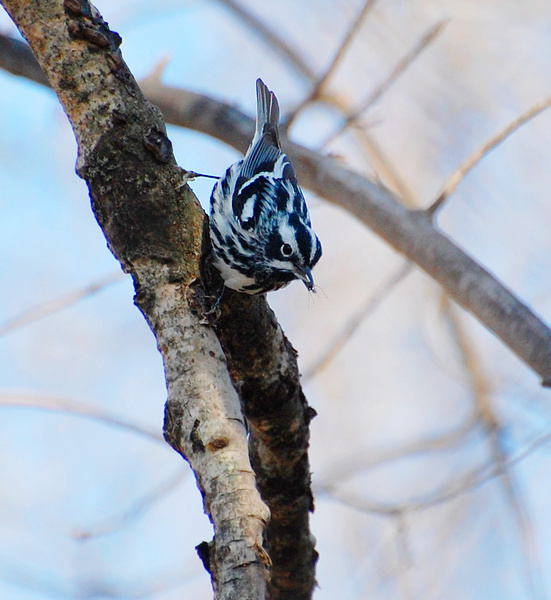
Black-and-White Warbler
Remember this one? I like to fondly imagine that it's the very same Black-and-White Warbler I saw splashing in a creek two months ago in a Costa Rica rainforest.
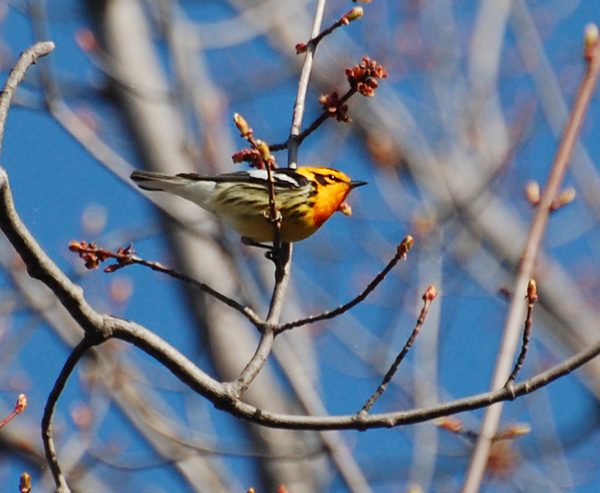
Blackburnian Warbler
My favorite bird in all North America, photographed for the first time. (Not photographed terribly well, I'm afraid, but it's a start!)
This is what the cars look like at Mud Lake, on a weekday morning, when the spring warblers finally get here:


Carara National Park (part 4)
May 6th, 2014
I wasn't above photographing the occasional reptile on a birding tour, either :-)
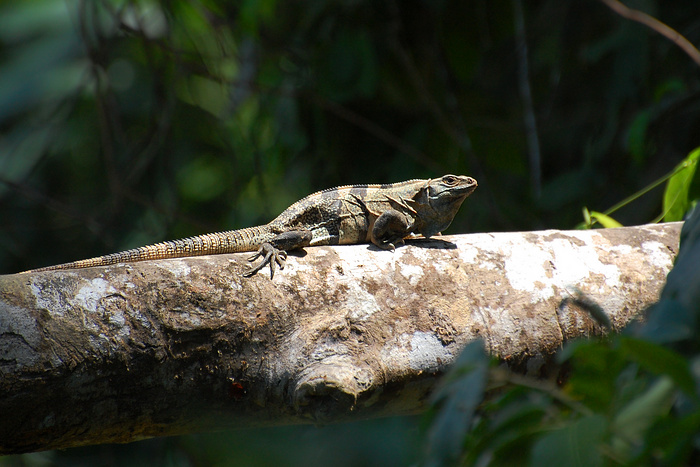
1680x1050 wallpaper
Nor flowers:
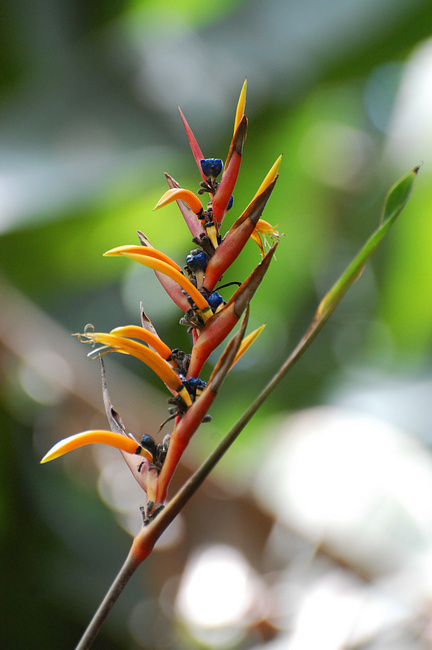
Familiar Turkey Vultures and Black Vultures were ubiquitous in Costa Rica (even on the beach!), but I saw only two King Vultures, both thanks to Johan. The first, my lifer, was in Esquipulas, and was too far away for even a bad picture. Johan spotted this one soaring soon after we came out into the open at the lagoon.
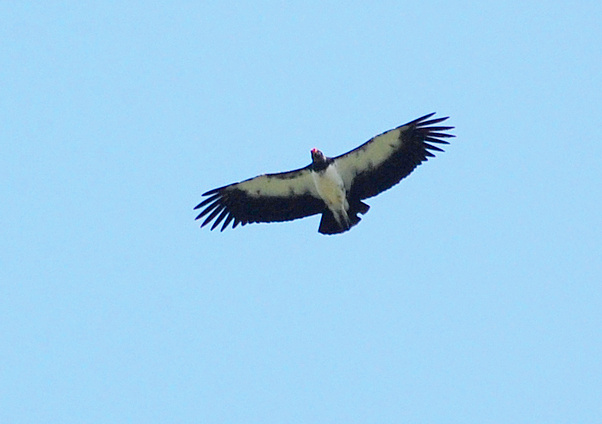
Here's what a King Vulture looks like up close. It's said they're called kings because when they descend to a carcass, other vultures make way. You can kinda see why.
Late in the day, Johan took us to a small creek which is known as a favorite evening bathing spot for a variety of birds, and we stayed there until sunset. This ended up being not only a high point in the Carara trip, but one of the high points of my whole vacation. Photographing it was difficult. The lighting was poor, and my camera wanted tons of exposure time to compensate; I could not possibly hold it steady enough to expose for that length of time without blur. Of course, disturbing the birds with flash was out of the question. I considered fiddling with the ISO setting, and our guide graciously offered to lend me his tripod, but in the end, I decided to just sit and enjoy.
A Red-Capped Manakin was the first to make an appearance. (Red-Capped Manakins, on account of their particular lek dance routine, are called "Michael Jackson birds." They moonwalk. (No, seriously--if you only ever click on one link in my blog, click on this one. You won't regret it.)) Then another, and another still. While one of them was splashing in the water, a Blue-Crowned Manakin perched right over his head--a visceral "wow" moment for both me and Michael. A Black-and-White Warbler (a wintering bird from North America) made an appearance, followed by a Sulphur-Rumped Flycatcher. A Long-Billed Hermit (at six inches, a comparatively enormous hummingbird) zipped in, dipped his tail, and zipped out. A late arrival was a nondescript brown bird called a Thrushlike Schiffornis, which our guide proclaimed to be the best (i.e. rarest) bird of the trip.
The most my camera (and some digital sharpening) could do:
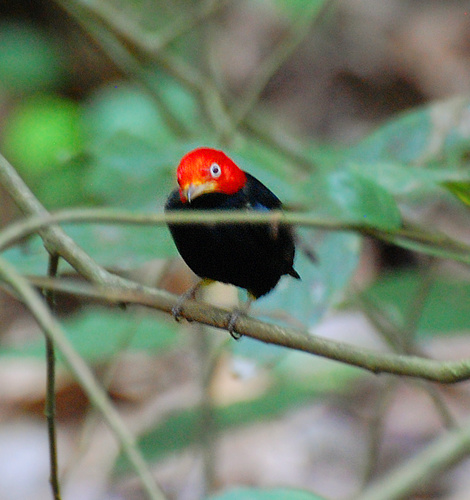
Red-Capped Manakin
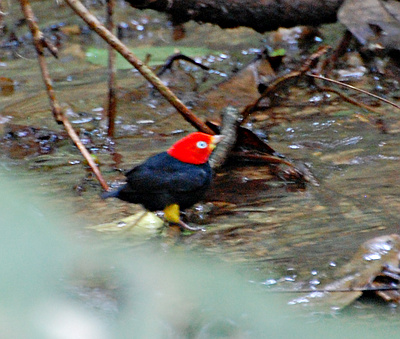
Those things that look like yellow leg warmers are part of the bird. He shows them off when lekking.
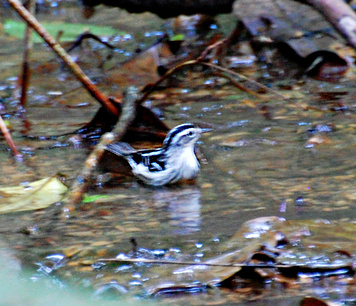
Black-and-White Warbler
When this incredible show was over, alas, Carara was over, and we hurried back down the trail before night set in, accompanied by the lion-like roars of a troop of Howler Monkeys.
|
